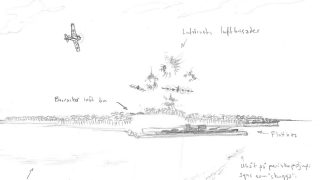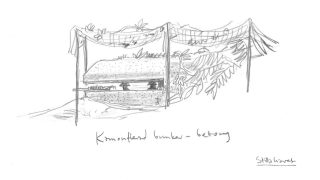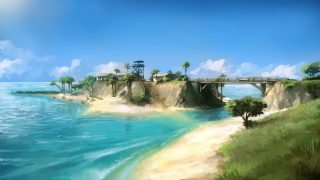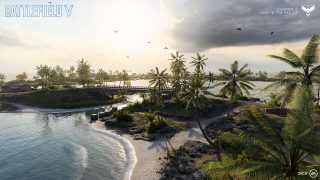Wake Island Now and Then: Reimagining a Classic
Battlefield veteran producer Lars Gustavsson shares insight into the map that started it all – and its upcoming reincarnation.


Lars Gustavsson is no stranger to fan service. Having worked ten years at a ventilation company, he moved on to co-create – and recreate – one of the most iconic virtual fighting grounds ever: Battlefield™ 1942’s Wake Island.
With the legendary map on its way to Battlefield™ V as part of Chapter 5: War in the Pacific in December, the time is right for a stroll down memory lane. We bombarded the producer, nicknamed Mr. Battlefield, with questions on the creation of the original Wake, the joy of early playtests, and how things have changed since 2002.
And, of course, whether the map is horseshoe- or banana-shaped.

In this penciled sketch of Wake Island, the notes highlight key points and units like barracks, AA guns, and a submerged submarine.
If someone told you back in 2002 that you’d be reimagining Wake Island for an eager community 17 years later, I guess you’d question their sanity?
- For sure. However, back then, we were also quite confident that this map – and Battlefield 1942 as a whole – could turn out really well. Having created Codename Eagle when working for Refraction Games – which DICE later acquired – we knew that an air-land-sea setup with 64 players could work. Bringing World War 2 into that, with all the gear from our favorite period movies, could be amazing.
At a time when no one had heard of Battlefield, what was the plan to convince publishers and players?
- When pitching the concept of air-land-sea battles for 64 players, publishers were saying “You can’t do it.” For a year we didn’t even have a publisher at all. Finally, EA Redwood Shores saw our work. They told us that if we could bring the Codename Eagle concept to a WW2 setting with 64 players, we’d have a deal. Then we just had to prove it!
It took a while until we could get an early version of Battlefield 1942 into the hands of players. At E3 2002 we set up a tiny booth. At first no one showed up. But as rumor spread, the lines became longer.

An early concept sketch of one of the island’s camouflaged concrete bunkers.
And then the demo with Wake Island was unleashed?
- Exactly, that was in August 2002. I remember going out for dinner with the team – and [studio CEO] Patrick Söderlund stayed behind to watch the demo figures coming in before joining us in the celebrations. The demo was sailing towards becoming one of the most popular games. With all the previous uncertainty this was truly a triumphant “Rocky moment” for us. It could be done.
Wake Island was key to this breakthrough. Not only was it the demo’s map, it was prominent in the Battlefield 1942 trailer, which was quite a unique asset. We tried to create something more cinematic, not just multiplayer chaos and gunfights, that told an underlying story with defenders and attackers in an ever-changing battle. This kicked off a proud tradition of creating grand Battlefield trailers.

Did you realize back then what the secret behind Wake Island’s appeal was?
- Visually it had a unique look for a war game – it was a tropical paradise instead of something grey and grim. The real-life history behind Wake Island was also a factor; if we had just made up the terrain and given it a name, it wouldn’t have been as intriguing. Players got insight into what happened on the island, and the unique battles the terrain catered to. Last but not least, the map’s shape was vital.
Speaking of that, let’s settle this once and for all: is Wake Island horseshoe-shaped or banana-shaped?
- This has been debated heavily at the studio over the years, so it depends on who you ask. I stand firm in the horseshoe camp. Marita is the banana-shaped one.

Early concept sketch of Wake Island’s key areas.
Gameplay-wise, what significance does that shape have?
- It’s a narrow battlefield, which encourages battles. We realized early that this design enabled a good overview and a different type of gameplay, as compared to other maps. The geography gives you several options; you can try flanking the enemy team using naval units or, attacking on land, move head-on into the fight. I also think that the map’s distances contrasting with its accessibility is interesting.
The U.S. and Japanese teams had different battle conditions, with one invading and one defending. With such an asymmetrical foundation, how did you keep Wake Island balanced?
- We tweaked the ratio of tickets between attackers and defenders, and the teams’ vehicle types were also a factor – the mobile carriers and destroyers could be anywhere, which a well-trained team could exploit. We didn’t have features like squads or squad spawning, so dying meant starting over from a control point or onboard a ship, which could be used as a balancing tool, too.
Could you describe the technological challenges of that time?
- By supporting 64 simultaneous players and several vehicles, we were already pushing the engine to its limits. This meant that the level of graphical detail was limited. But limitations aren’t always bad. For Wake Island, less graphical detail helped portray the desolate paradise look that we were going for. Other environments were harder to recreate in that regard, such as bombed-out urban environments like Stalingrad.
Having a small team was challenging, too. Take the sound department, for instance. For the new Wake Island, we’ve sent an entire crew across the world to capture audio like Zero planes running on original engines. For Battlefield 1942’s sound design, we had one sound designer (supported by two coders), creating audio for all 16 maps, weapons, vehicles, and more. I remember him spending a coffee-fueled Easter, plotting the sounds of waves crashing onto the shoreline, based on player movement. On Monday, someone had accidentally overwritten all his files. Interesting times!

What are the key differences between the original Wake Island and the reimagination in Battlefield V?
- For every iteration, we’ve improved some aspects but also worked to maintain that original flavor that made Wake Island special. There are some obvious improvements, like crisper visuals. Beyond that, the map is bigger. We’ve increased the terrain size to create better pacing, but there are also more places for infantry to hide, such as foliage and rock formations.
Fortifications are another new interesting aspect. Since Wake Island is a linear map, you can use them smartly to stop opponents. Battlefield 1942 was quite a static world; your battles never really left any marks. With Battlefield 1943, destruction became a part of the experience in a completely different way. And today, in Battlefield V, the game itself is a journey through the years where you can see the evolution: destruction, Fortifications, and new game modes.

How will you play the new Wake Island on release day?
- Tricky! I’ll either hit Conquest Assault or Breakthrough since both modes add something interesting to the map. I’ve played a ton during development, but I look forward to sitting on the couch and capping flags at home. I like playing in public squads and I tend to take the squad leader role.
Playing with random groups with people who really cooperate can be very special. You’re thrown together by chance, you don’t know each other, but you work towards a common goal. It says something about us as human beings, in a way.
And will Wake Island 2019 be the worthy reimagination we’re all hoping for?
- I believe so! Our early test rounds have been great fun. The other day, we were hosting a Battlefield V playtest for our GameChangers, and there was this crazy conclusion to a Breakthrough match on the new Wake Island. The attacking team miraculously cleared the final sector and won at the last minute. This included a lot of screaming – and I got déjà vu remembering our own excited noises when internally playtesting Wake Island 17 years ago.
I thought back then: “If we can have this much fun from just testing the game, how good will the final version be?”
That’s where our confidence came from; simply having fun when playing.
– Jonas Elfving
See you on the battlefield – and on Twitter, Instagram, Facebook, YouTube, Reddit, Discord, and the Battlefield Forums. Sign up to receive emails with news, offers, and more about Battlefield and other EA products.
This announcement may change as we listen to community feedback and continue developing and evolving our Live Service & Content. We will always strive to keep our community as informed as possible. For more information, please refer to EA’s Online Service Updates at https://www.ea.com/service-updates.
